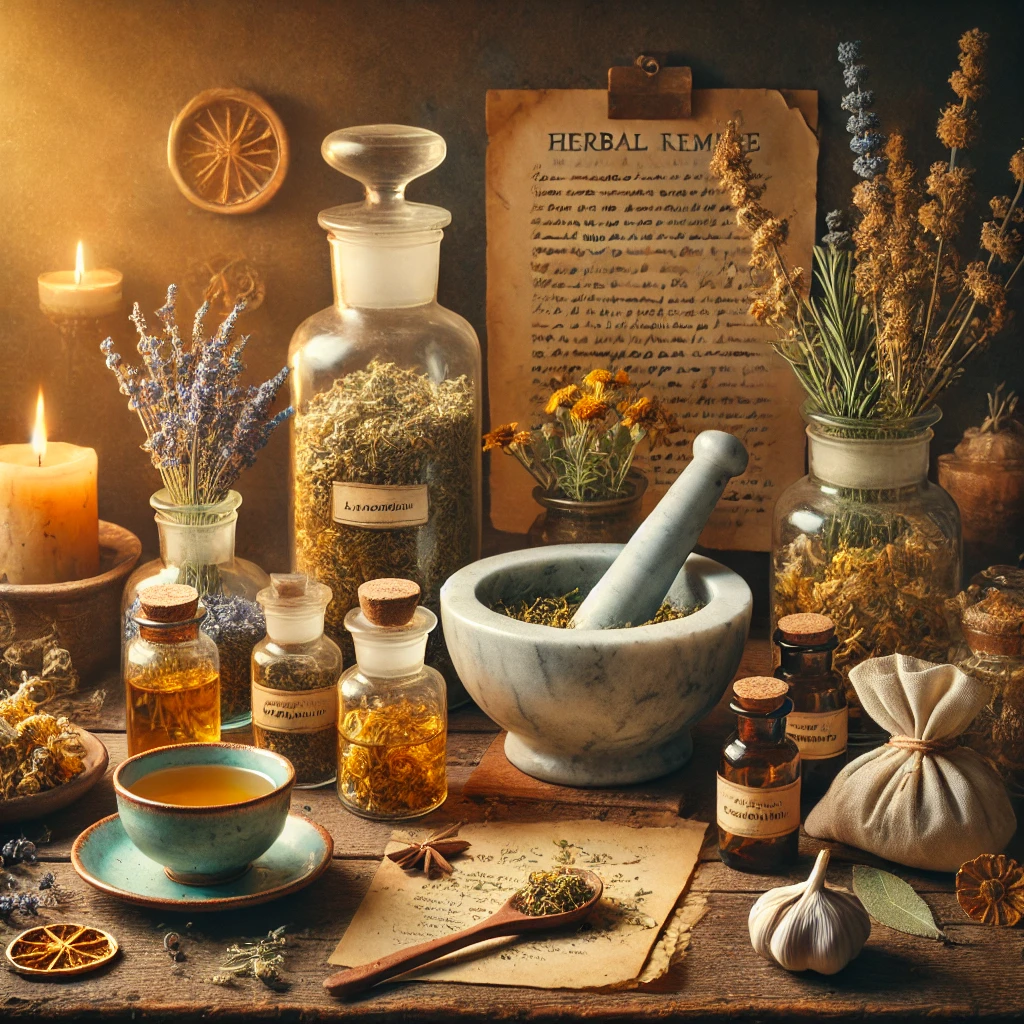Overview
Folk Herbal Remedies are time-tested, community-based healing practices that use plants, roots, flowers, and natural ingredients to support health and treat common ailments. Rooted in oral traditions and ancestral wisdom, folk remedies reflect the intimate relationship between people and the land—where healing knowledge is passed down through families, local healers, and cultural rituals.
These remedies are not just medicinal; they often carry symbolic, spiritual, and energetic significance. They represent a form of earth-based healing that blends practicality with intuition, ritual, and soul care.
Core Principles of Folk Herbalism
1. Accessible & Practical Healing
- Based on locally available herbs and materials.
- Remedies often prepared in kitchens, gardens, or home altars.
- Emphasizes prevention, nourishment, and balance, not just cure.
2. Ancestral and Oral Traditions
- Passed through generations without formal texts.
- Includes “kitchen witchery”, granny magic, or curanderismo, depending on the region.
- Uses storytelling, rituals, songs, and intuitive healing practices.
3. Spirit and Ritual Integration
- Many folk remedies are combined with prayer, blessings, chants, or protective charms.
- Illness may be seen as both a physical imbalance and spiritual disharmony.
Common Folk Herbal Remedies by Ailment
| Ailment | Folk Remedy | Herbs Used |
|---|---|---|
| Colds & Flu | Herbal steam inhalation, garlic-honey syrup | Elderberry, garlic, thyme, mullein |
| Digestive Upset | Herbal tea blends or bitters | Peppermint, fennel, chamomile, ginger |
| Anxiety & Insomnia | Calming herbal infusions or pillow sachets | Lavender, valerian, lemon balm |
| Wounds & Infections | Poultices or salves | Plantain, yarrow, calendula |
| Menstrual Cramps | Warm compresses with herb oils, teas | Cramp bark, raspberry leaf, mugwort |
| Headaches | Cold herb compresses, aromatic oils | Feverfew, peppermint, rosemary |
| Protection & Blessing | Smudging, bath rituals, or home sprays | Rue, sage, rosemary, basil |
Traditional Preparation Methods
- Teas & Infusions: Steeping herbs in hot water for nourishment or calm.
- Tinctures: Alcohol or vinegar-based extracts for potent use.
- Syrups: Sweet herbal formulas often made with honey or molasses.
- Salves & Balms: Herbal oils mixed with beeswax for wounds or skin conditions.
- Poultices: Crushed herbs applied to skin to draw out heat or infection.
- Baths & Foot Soaks: Used for energetic clearing and physical relief.
- Smudging & Incense: Used for space clearing and ritual protection.
Energetic and Spiritual Aspects
Many folk herbal traditions include:
- Warding and Protection: Herbs like rue, basil, garlic hung over doorways or placed in pockets.
- Blessings and Charms: Herbal sachets under pillows, in shoes, or carried for love, luck, or safety.
- Lunar Timing: Harvesting, planting, and preparing herbal remedies according to the moon cycle.
- Prayer and Intention: Herbs are often blessed before use to charge them with healing energy.
Regional Examples
| Tradition | Region/Culture | Unique Features |
|---|---|---|
| Appalachian Herbalism | United States | Mix of Native, European, and African traditions |
| Curanderismo | Latin America | Integrates herbs with spiritual cleansing (limpia) |
| Romani Herbal Wisdom | Europe | Deep knowledge of nature’s rhythms and protective remedies |
| Afro-Caribbean Traditions | Caribbean & diaspora | Includes spiritual baths, rootwork, and ancestral rituals |
| Nordic Folk Healing | Scandinavia | Uses birch, pine, moss, and sacred seasonal plants |
Modern Revival & Integration
- Folk herbalism is experiencing a renaissance as people return to ancestral healing.
- Many integrate it with modern herbalism, energy work, intuitive healing, and ritual.
- Herbal folk schools, apprenticeships, and home practice circles are growing globally.
Cautions & Considerations
- Always ensure correct plant identification.
- Know dosage and contraindications (e.g., pregnancy, medication interactions).
- When in doubt, consult a trained herbalist or holistic practitioner.
- Respect and honor the cultural roots of remedies—avoid dilution or appropriation.
Related Subcategories
This entry aligns with:
- Herbal Healing Systems
- Ancestral & Folk Traditions
- Rituals & Ceremonial Tools
- Mind-Body-Spirit Therapies
- Ethical & Cultural Healing Practices
Visual Element Recommendation
Suggested Visuals:
- Infographic: “Top 10 Folk Herbal Remedies for Everyday Ailments”
- Background Image: “Vintage Kitchen Table with Herbs, Candle, and Mortar”
- Carousel Post: “Global Folk Herbal Traditions You Should Know”

